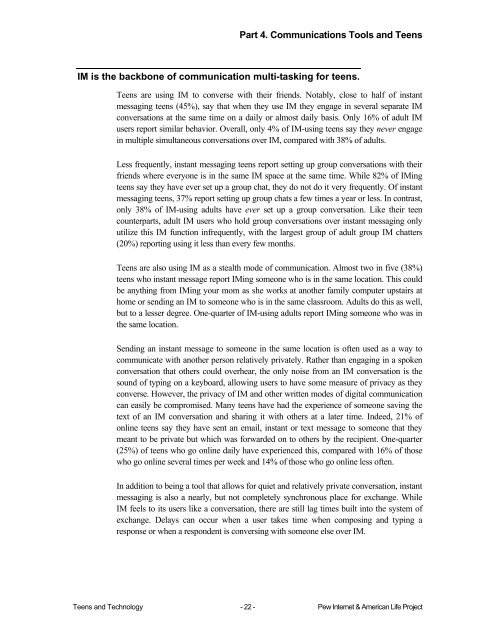Teens and Technology - Pew Internet & American Life Project
Teens and Technology - Pew Internet & American Life Project
Teens and Technology - Pew Internet & American Life Project
You also want an ePaper? Increase the reach of your titles
YUMPU automatically turns print PDFs into web optimized ePapers that Google loves.
Part 4. Communications Tools <strong>and</strong> <strong>Teens</strong><br />
IM is the backbone of communication multi-tasking for teens.<br />
<strong>Teens</strong> are using IM to converse with their friends. Notably, close to half of instant<br />
messaging teens (45%), say that when they use IM they engage in several separate IM<br />
conversations at the same time on a daily or almost daily basis. Only 16% of adult IM<br />
users report similar behavior. Overall, only 4% of IM-using teens say they never engage<br />
in multiple simultaneous conversations over IM, compared with 38% of adults.<br />
Less frequently, instant messaging teens report setting up group conversations with their<br />
friends where everyone is in the same IM space at the same time. While 82% of IMing<br />
teens say they have ever set up a group chat, they do not do it very frequently. Of instant<br />
messaging teens, 37% report setting up group chats a few times a year or less. In contrast,<br />
only 38% of IM-using adults have ever set up a group conversation. Like their teen<br />
counterparts, adult IM users who hold group conversations over instant messaging only<br />
utilize this IM function infrequently, with the largest group of adult group IM chatters<br />
(20%) reporting using it less than every few months.<br />
<strong>Teens</strong> are also using IM as a stealth mode of communication. Almost two in five (38%)<br />
teens who instant message report IMing someone who is in the same location. This could<br />
be anything from IMing your mom as she works at another family computer upstairs at<br />
home or sending an IM to someone who is in the same classroom. Adults do this as well,<br />
but to a lesser degree. One-quarter of IM-using adults report IMing someone who was in<br />
the same location.<br />
Sending an instant message to someone in the same location is often used as a way to<br />
communicate with another person relatively privately. Rather than engaging in a spoken<br />
conversation that others could overhear, the only noise from an IM conversation is the<br />
sound of typing on a keyboard, allowing users to have some measure of privacy as they<br />
converse. However, the privacy of IM <strong>and</strong> other written modes of digital communication<br />
can easily be compromised. Many teens have had the experience of someone saving the<br />
text of an IM conversation <strong>and</strong> sharing it with others at a later time. Indeed, 21% of<br />
online teens say they have sent an email, instant or text message to someone that they<br />
meant to be private but which was forwarded on to others by the recipient. One-quarter<br />
(25%) of teens who go online daily have experienced this, compared with 16% of those<br />
who go online several times per week <strong>and</strong> 14% of those who go online less often.<br />
In addition to being a tool that allows for quiet <strong>and</strong> relatively private conversation, instant<br />
messaging is also a nearly, but not completely synchronous place for exchange. While<br />
IM feels to its users like a conversation, there are still lag times built into the system of<br />
exchange. Delays can occur when a user takes time when composing <strong>and</strong> typing a<br />
response or when a respondent is conversing with someone else over IM.<br />
<strong>Teens</strong> <strong>and</strong> <strong>Technology</strong> - 22 - <strong>Pew</strong> <strong>Internet</strong> & <strong>American</strong> <strong>Life</strong> <strong>Project</strong>
















